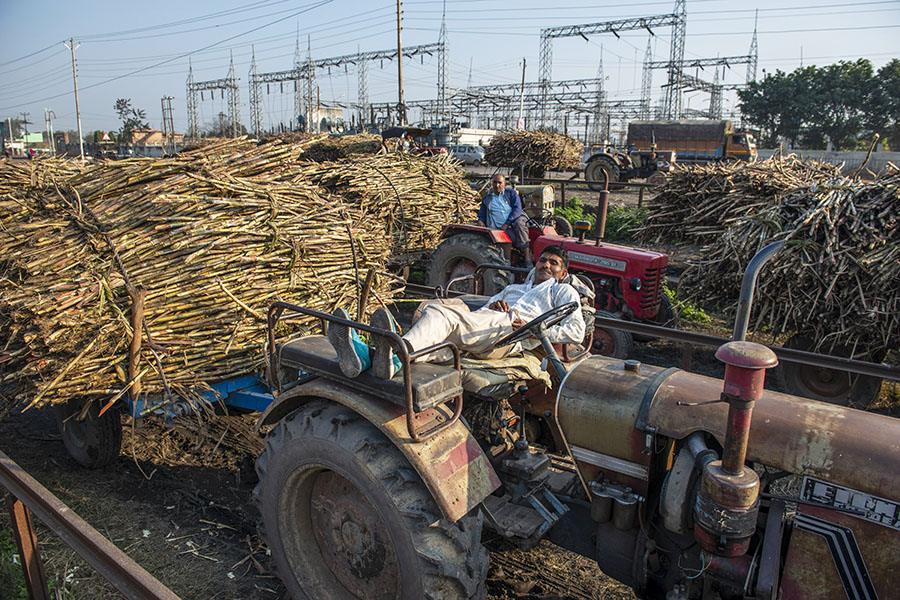
Explained: What is the Fair and Remunerative Price
It assured timely payment to farmers, irrespective of the profit and loss to sugar mills. Over 5 crore sugarcane farmers are likely to benefit from it, but the increase in production cost could be passed on to end-consumers
 (File) Sugarcane farmers are seen in a queue waiting to sell harvested sugarcane outside at Baghpat cooperative sugar mills ltd, Baghpat. Image: Pradeep Gaur/SOPA Images/LightRocket via Getty Images
(File) Sugarcane farmers are seen in a queue waiting to sell harvested sugarcane outside at Baghpat cooperative sugar mills ltd, Baghpat. Image: Pradeep Gaur/SOPA Images/LightRocket via Getty Images
The Cabinet Committee on Economic Affairs on Wednesday hiked the Fair and Remunerative Price (FRP) for sugarcane by 8 percent to Rs340 per quintal for 2024-25, from Rs315 per quintal in 2023-24. As per the revised rates, the sugar mills will pay the latest price to the farmers for a recovery rate of 10.25 percent from October 1.
The sugar mills will pay an additional Rs3.32 for an increase of 0.1 percent in recovery. Similarly, for a 0.1 percent reduction in recovery, the same amount will be deducted. As per the new rate, the minimum price for sugarcane will be Rs315.1 per quintal at a recovery rate of 9.5 percent.
What is FRP?
FRP was introduced by the government in 2009 by an amendment to the Sugarcane (Control) Order, 1966. It replaced the Statutory Minimum Price (SMP) on the Commission for Agricultural Costs and Prices (CACP) consultation.The FRP system assured timely payment to farmers, irrespective of the profit and loss to sugar mills. Further, the new system made it mandatory for sugar mills to pay the farmers within 14 days of delivery of sugarcane.
Additionally, the FRP system introduced grading on the basis of sugar recovery rate from sugarcane wherein a premium was paid to the farmer on higher recovery and a reduction in rates on lower recovery. Currently, the standard recovery rate is 10.25 percent, and premium and deduction rates are Rs3.32 on 0.1 percent recovery.
Earlier in 2022, the Maharashtra government made changes in the payment method of FRP through a resolution that allowed sugar mills to pay FRP in two tranches—one at the time of delivery (within 14 days) and another after the closure of the mill upon the calculation of recovery instead of relying on the previous year’s recovery. The resolution led to huge protests by farmers as the second installment time was months after the delivery of sugarcane. After the protest, the Maharashtra government resorted to the one-time payment of FRP.
Also read: Farmer protests: X 'disagrees' with government order to block accounts in notable post-acquisition stance
Effect of new FRP
Sugar production in India was hit hard in the October-December 2023 quarter as production fell 11.21 million metric tonnes; it was 12 million in the same quarter the previous year. The increase in FRP is going to increase the cost for producers. After the minister's statement on revised rates, shares of major sugar-producing companies fell on Thursday. Shares of Bajaj Hindustan Sugar Ltd fell by 2.6 percent. Similarly, those of Uttam Sugar Mills and Shree Renuka Sugar Mills fell by 1.98 and 1.21 percent, respectively.As per the Ministry of Consumer Affairs statement, the increased FRP will benefit over five crore sugarcane farmers in the country. However, the increase in production cost could affect end-consumers as well.
“Factors such as FRP hikes, akin to MSP, make it attractive to farmers but also increase prices in the local market as mills pass on that cost to consumers, which has occurred,” says Aditya Sesh, a member of the Expert Committee in the Ministry of Agriculture & Farmers Welfare, Government of India. “In an election year, the government releases sugar from its reserves to maintain price levels. Consequently, sugar prices in India are expected to remain elevated for at least this year, despite the aforementioned factors.”


















